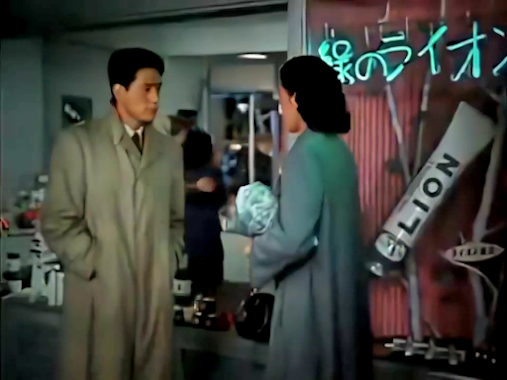Obscure Japanese Film #109
 |
| Mariko Okada |
Toho’s first feature film in full colour concerns the Ishii family, who live in the rural area of Kanagawa, an hour away from Tokyo by train. The head of the household, Sahei Ishii (Makoto Kobori), grows pears and takes great pride in his work, stubbornly refusing to take the easy option and sell his land for what would be a considerable profit. It is assumed that his eldest son, Seitaro (Kiyoshi Kamoda), will inherit the land and continue the family business.
 |
| Yoko Sugi |
The older of Sahei’s two daughters, Yoshiko (Yoko Sugi), commutes to Tokyo, where she is employed at a hotel with hideously garish décor presumably designed to show off the new Fujicolor process. She has a boyfriend, Junichi (Hiroshi Koizumi), who works at the hotel as an electrician, but he’s been offered a better job in far-off Okinawa and wants her to join him.
 |
| Keiju Kobayashi |
Yoshiko’s younger sister, Momoko (Mariko Okada), is rather bored with country life and dreams of the bright lights of Tokyo. She’s also starting to become interested in the opposite sex so, when Kitakoji (Akihiko Hirata, the one-eyed scientist from the original Godzilla), a music student from the capital, moves in next door, she quickly falls in love with him and his fancy Tokyo ways. Then Seitaro gets hit by a truck and dies, so Sahei puts pressure on Yoshiko to marry Katsuzo (Keiju Kobayashi), a young local whose only ambition is to grow pears…
 |
| Yoko Sugi |
This is a very conservative film whose drama revolves around the classic Japanese formula of giri (obligation) versus ninjo (inclination), especially in the case of Yoshiko, who feels a strong sense of duty towards her family but wants to go off to Okinawa with Junichi. The film also pits the countryside against the city. Ultimately, giri and the countryside win – almost nobody gets what they thought they wanted, but it all works out alright in the end. Wanting to go off to Tokyo is seen as youthful folly, i.e. something the young naturally have to get out of their system before they can become sensible and mature human beings. The roles of the two sisters are reversed at the end when Momoko gets a job in Tokyo, but there’s a sense that sooner or later she’ll become disillusioned with city life and return to Kanagawa.
 |
| Yoko Sugi and Mariko Okada |
There’s also a subplot involving a Japanese-American woman at the hotel who is married to an American the cops want to arrest for fraud. This distrust-of-the-foreigner element may be partly due to the fact that the American occupation had ended the year before, so Japanese filmmakers were now free to be critical of the Americans again. However, Toho rather wants to have its cake and eat it on this point, as the music score by Raymond Gallois-Montbrun could hardly be less Japanese and smacks of Hollywood.
Despite its questionable ideology, Girls in the Orchard is not without its charms, and most of the characters – which also include Eijiro Tono as a drunken uncle – are likeable and easy to care about. The success of the colour process is difficult to judge given the poor quality of the copy I watched, but it’s certainly not one of the more subtle uses of colour I’ve seen.
Girls in the Orchard was co-written and directed by Kajiro Yamamoto (1902-74), a director whose name has survived mainly as a footnote; he was Akira Kurosawa’s mentor, and few of his own films are easily accessible today.
Bonus trivia: The film contains an early example of blatant product placement in a couple of scenes featuring Lion toothpaste, a Japanese brand.
 |
| Hiroshi Koizumi, Yoko Sugi and Lion Toothpaste |
Note on the title: The Japanese title translates more accurately as ‘Girls in Blossom’ (although another possibility would be ‘Blooming Girls’, which of course is much better).

No comments:
Post a Comment